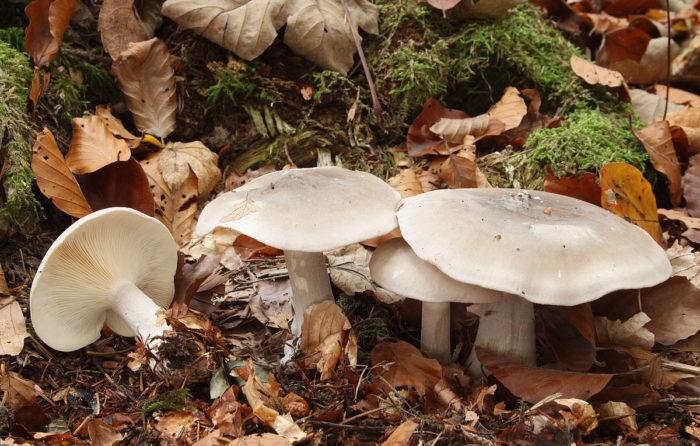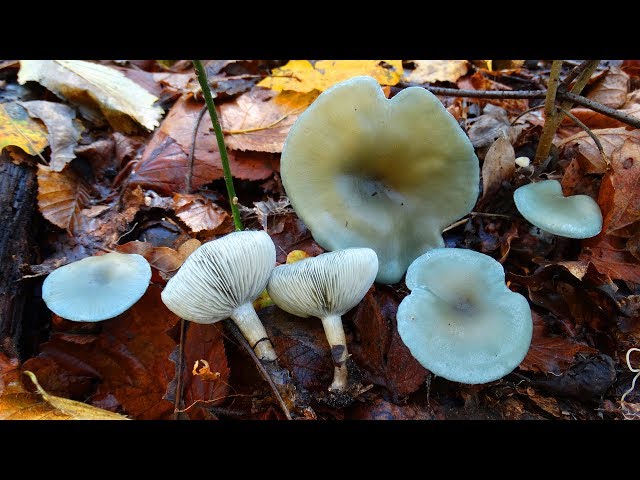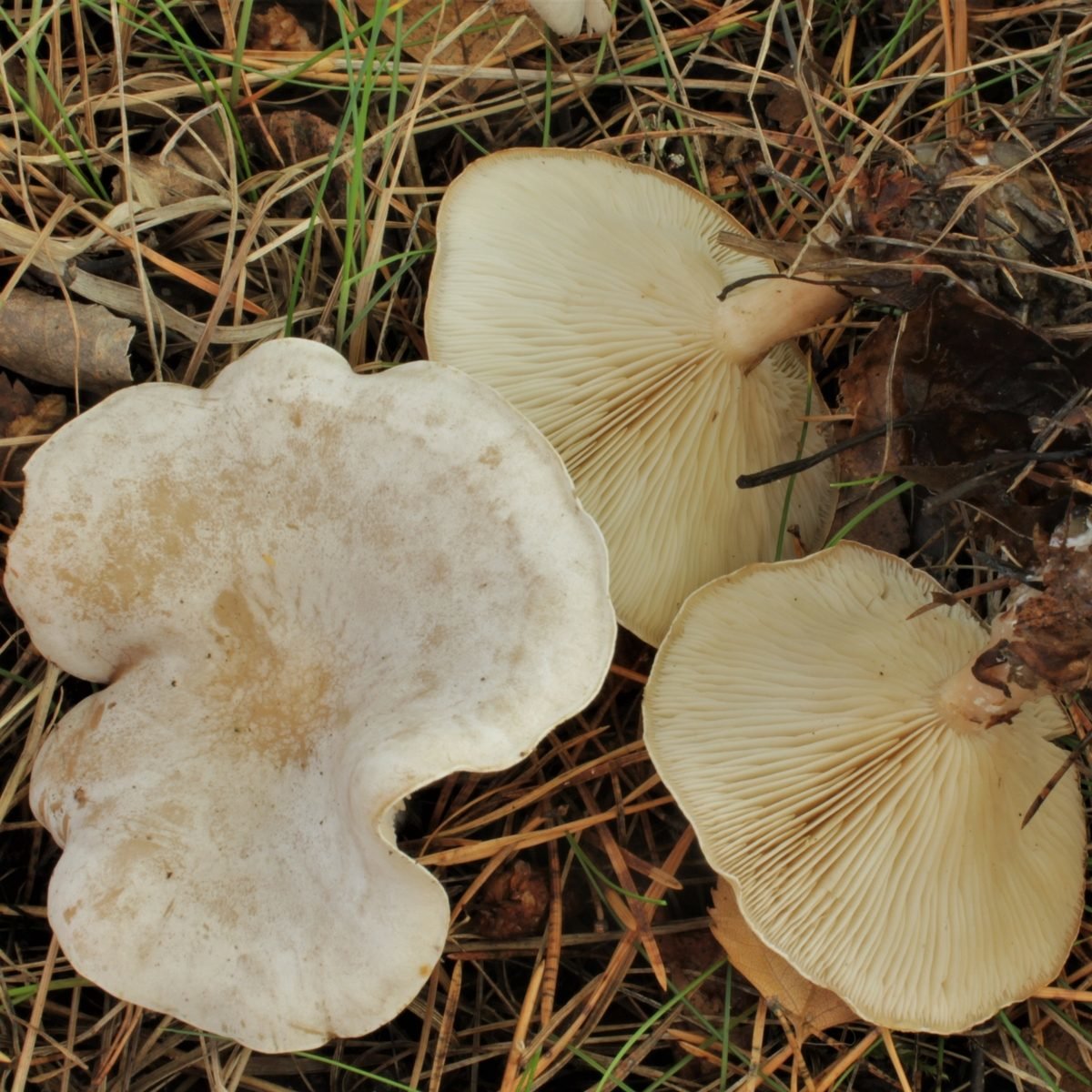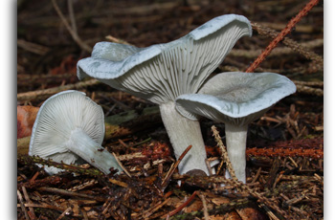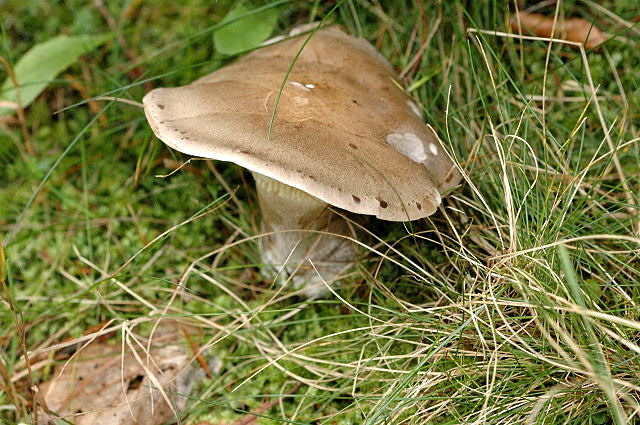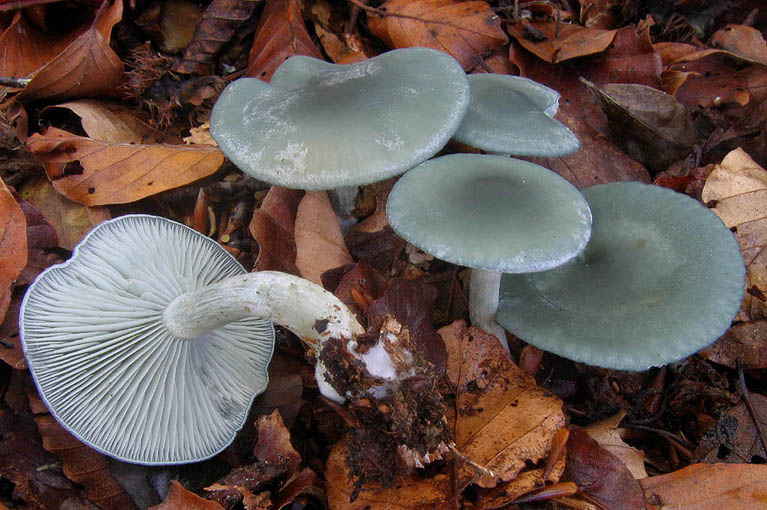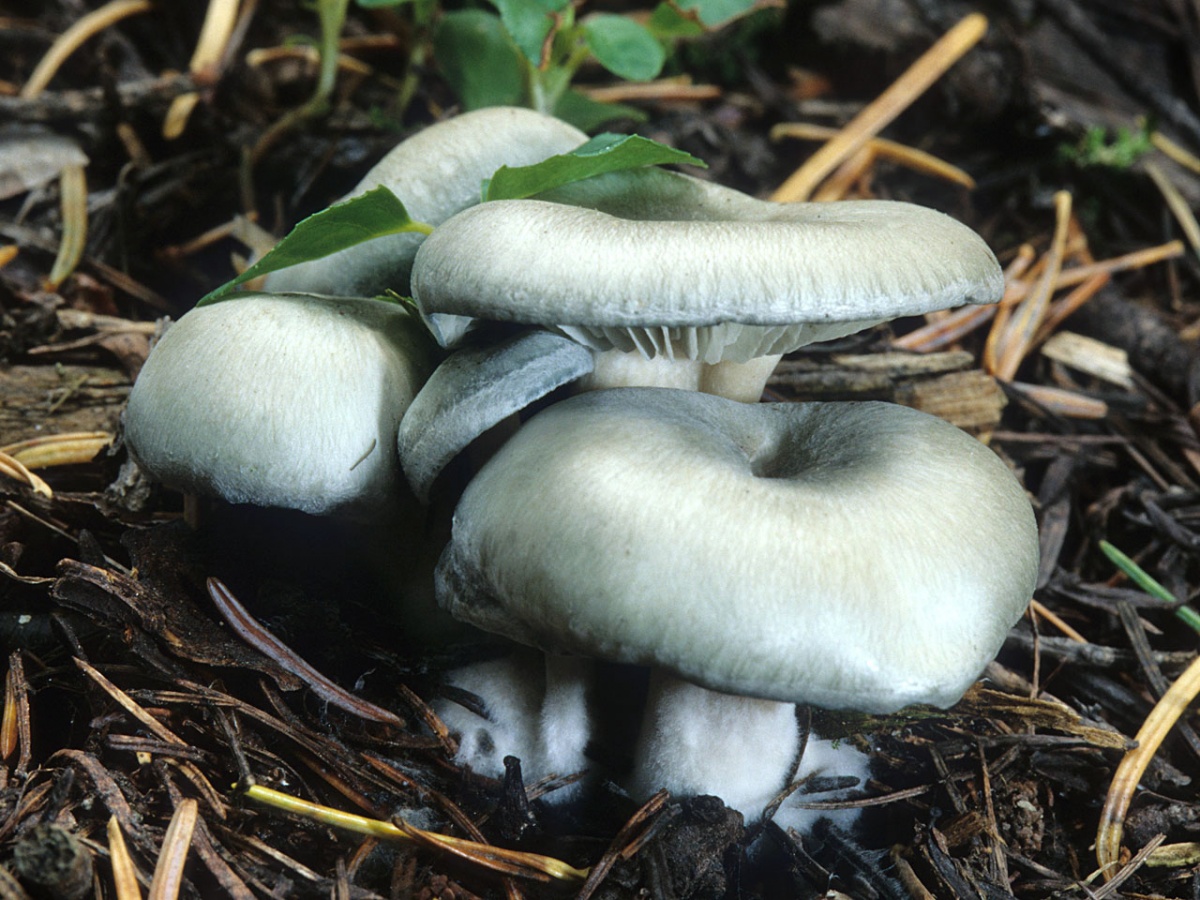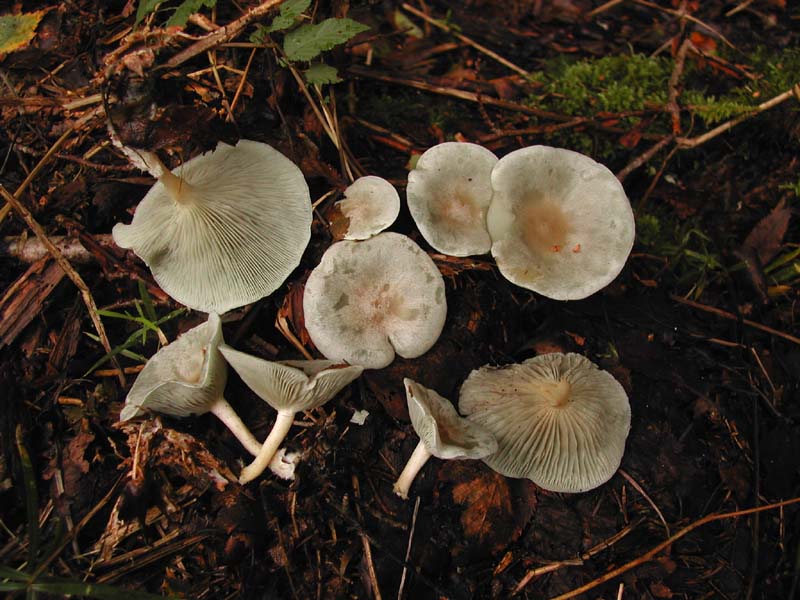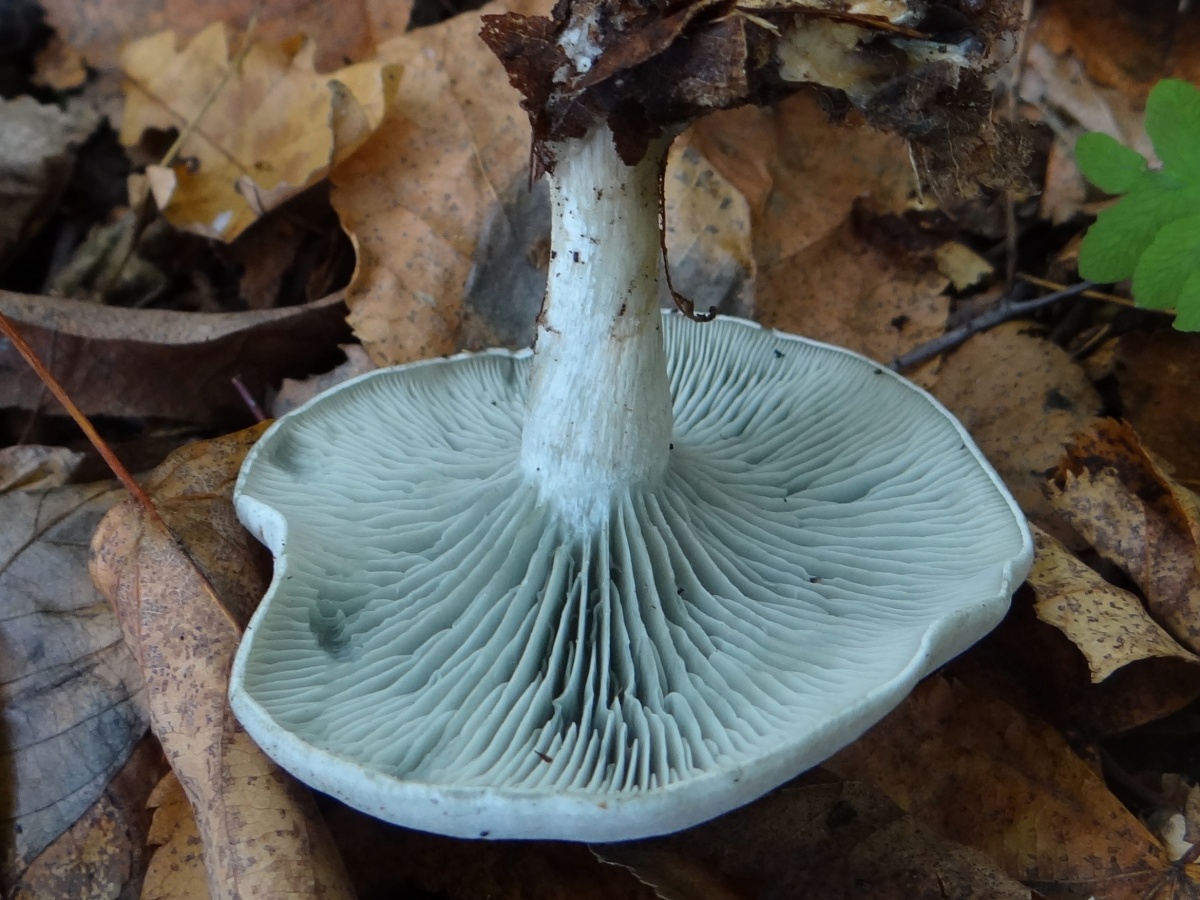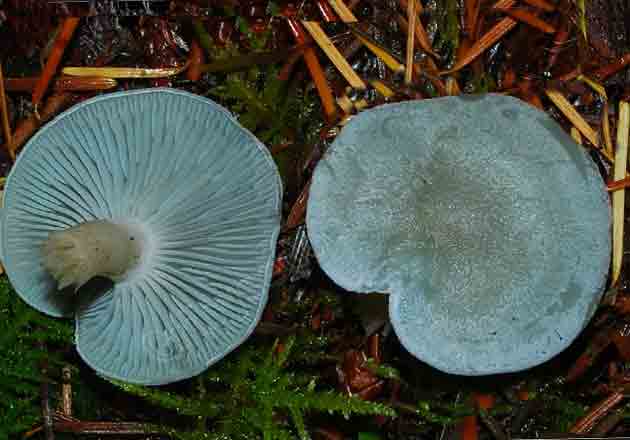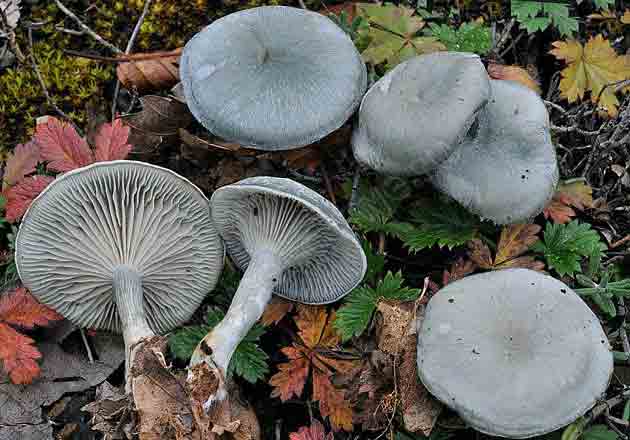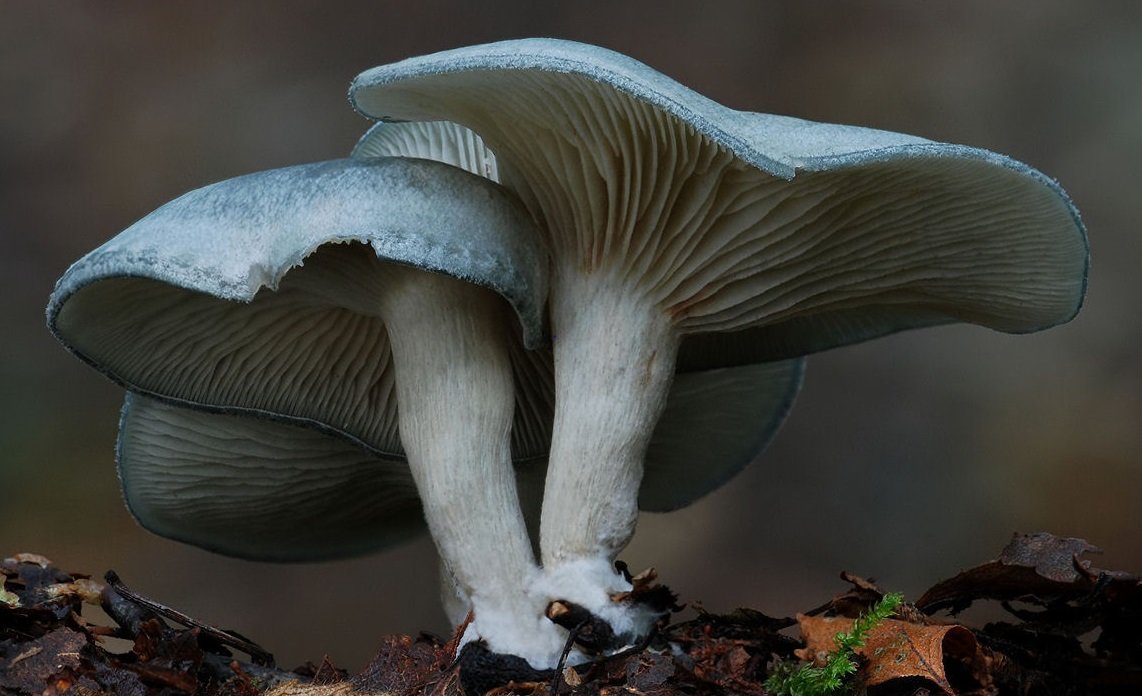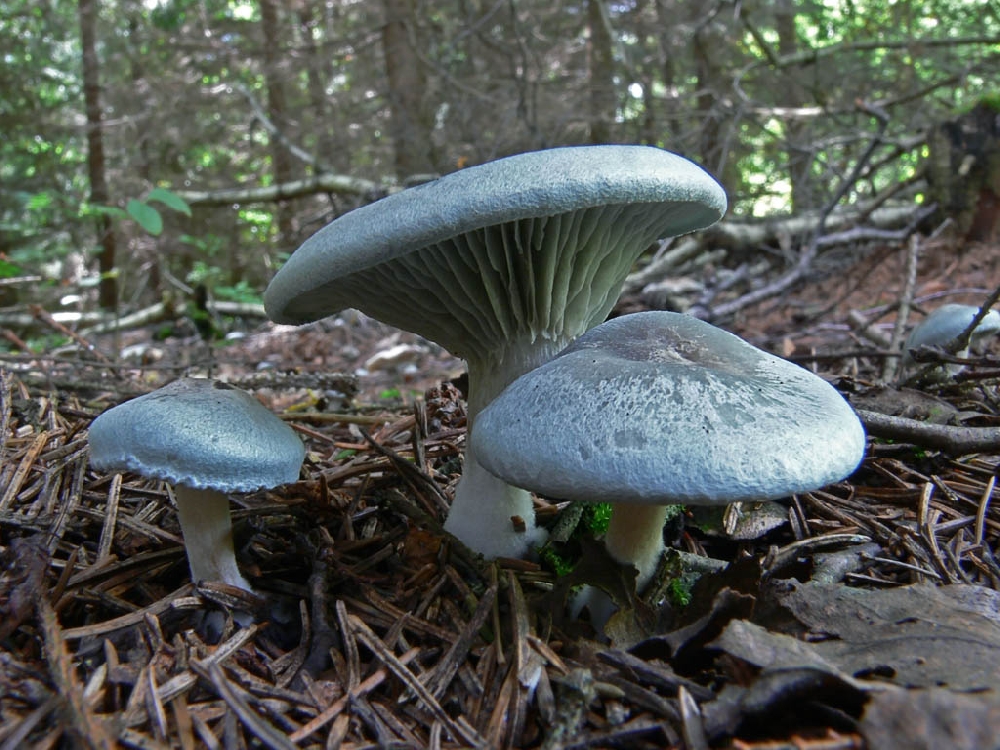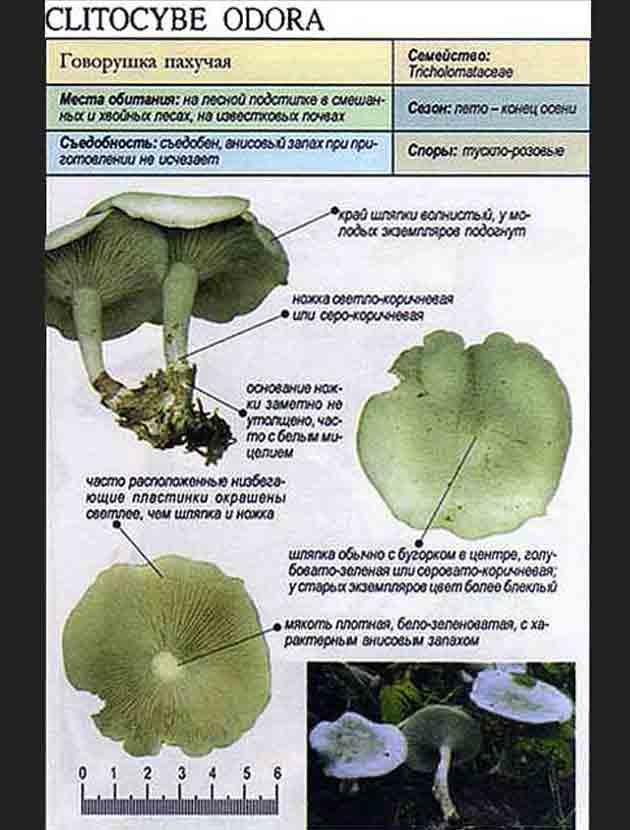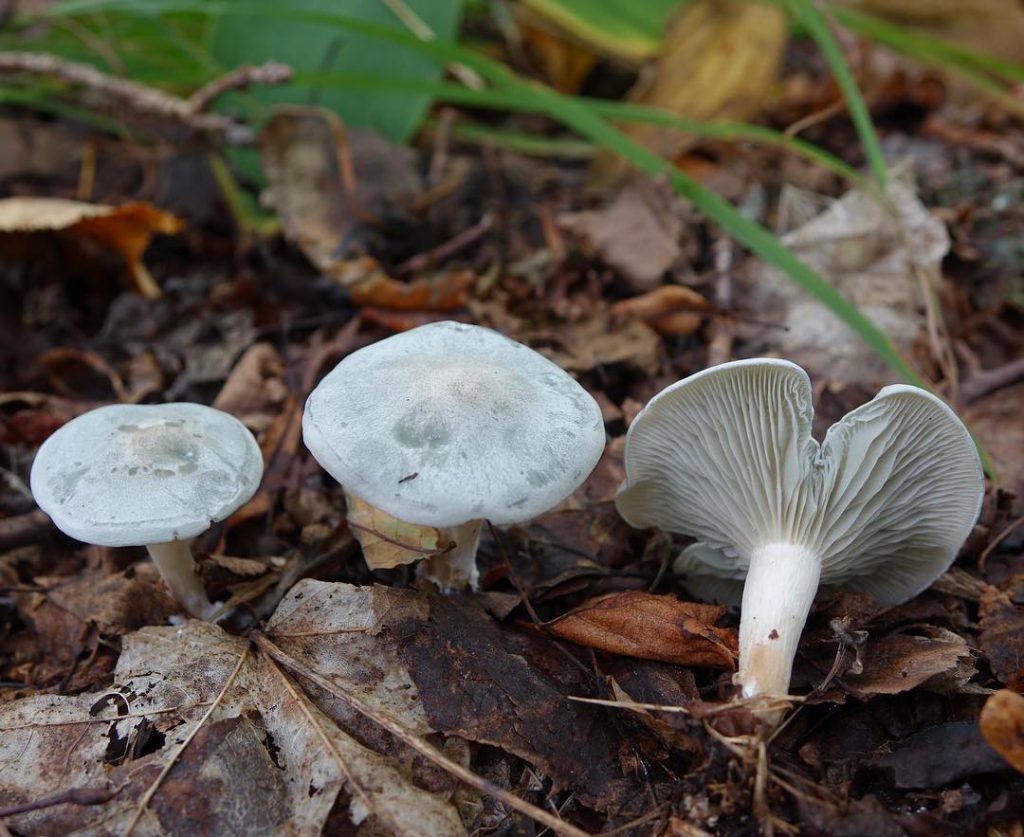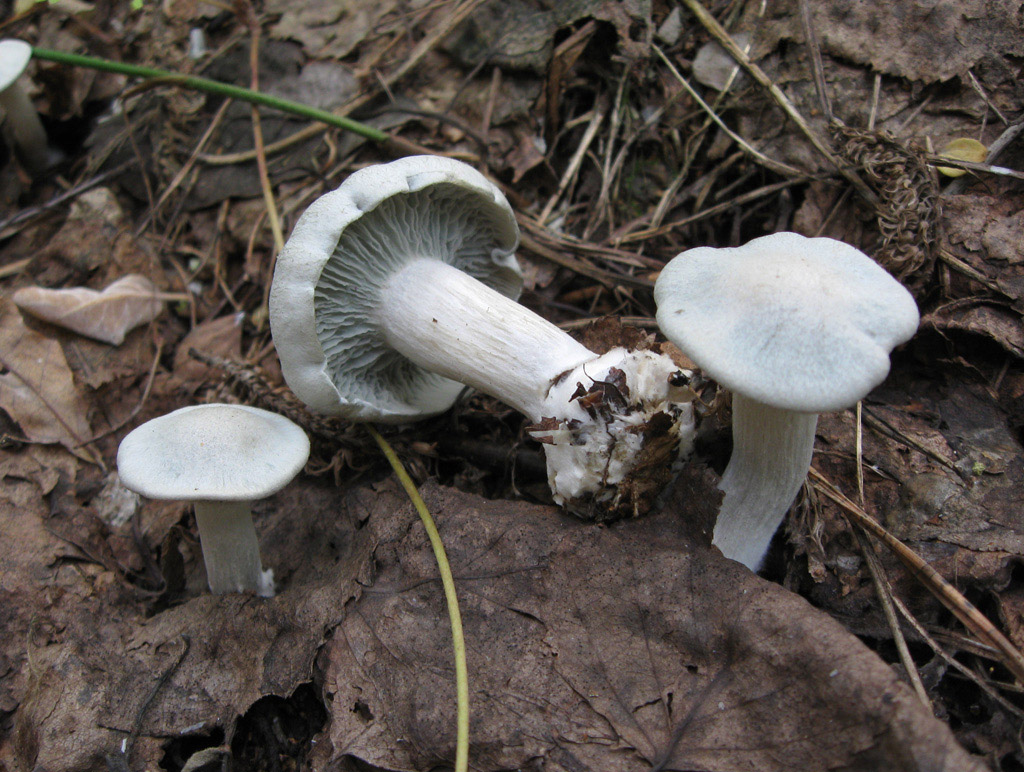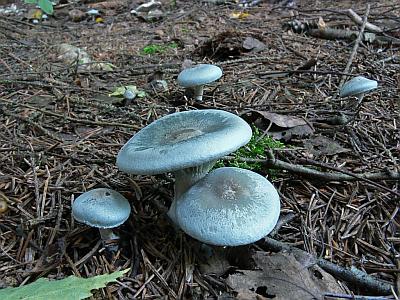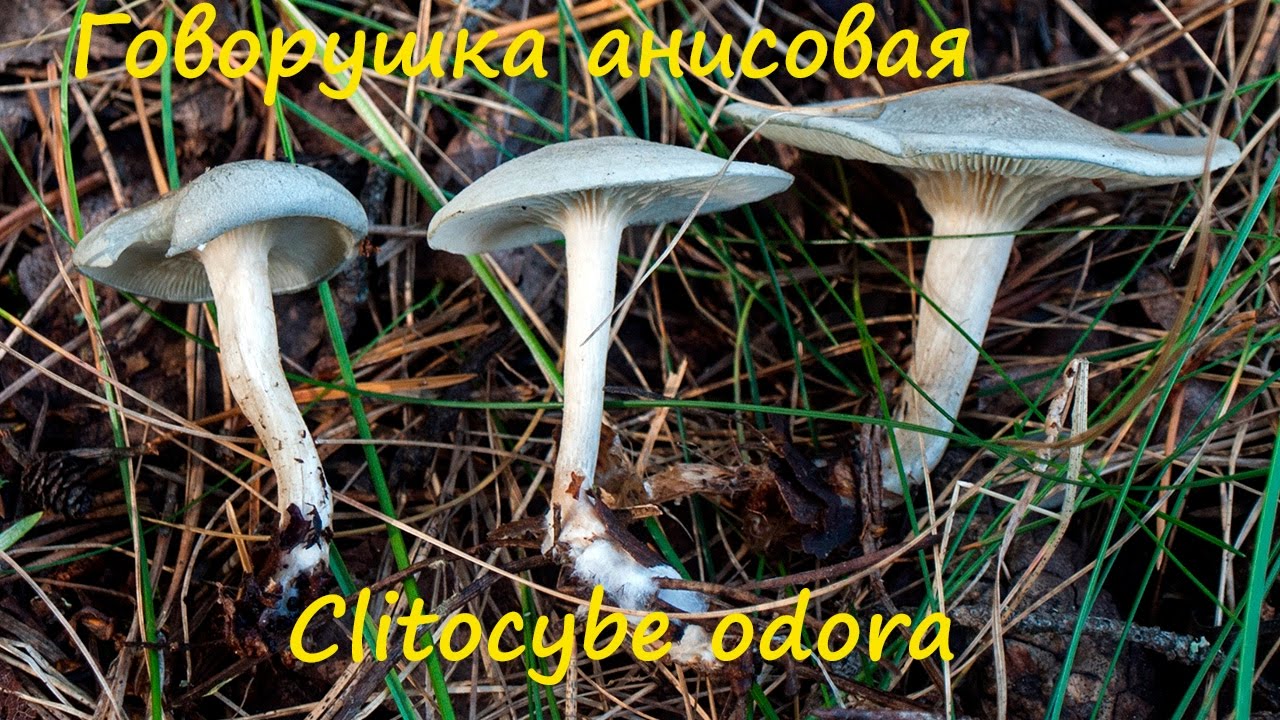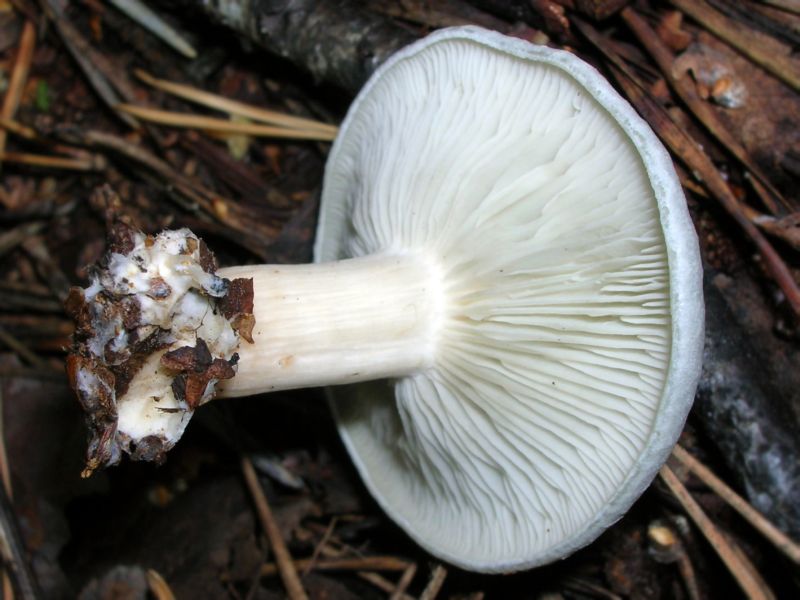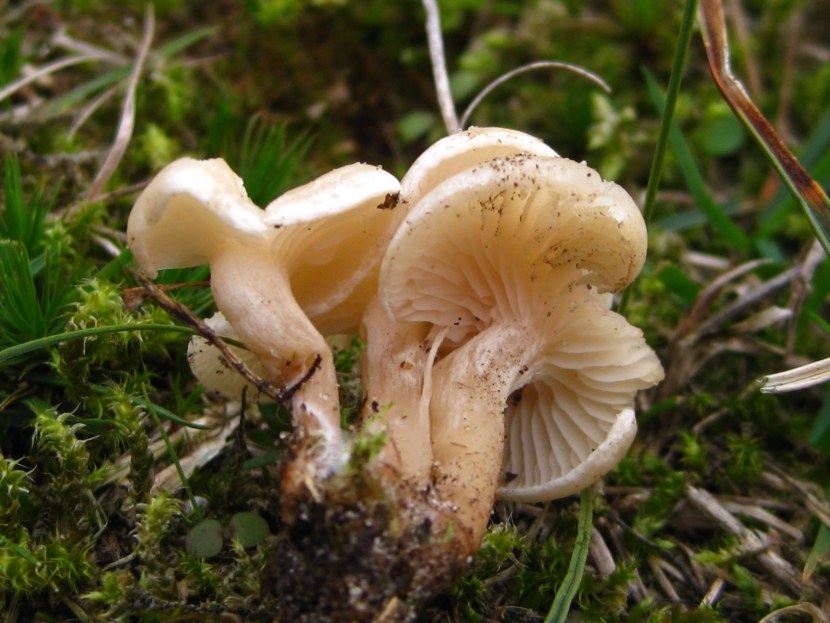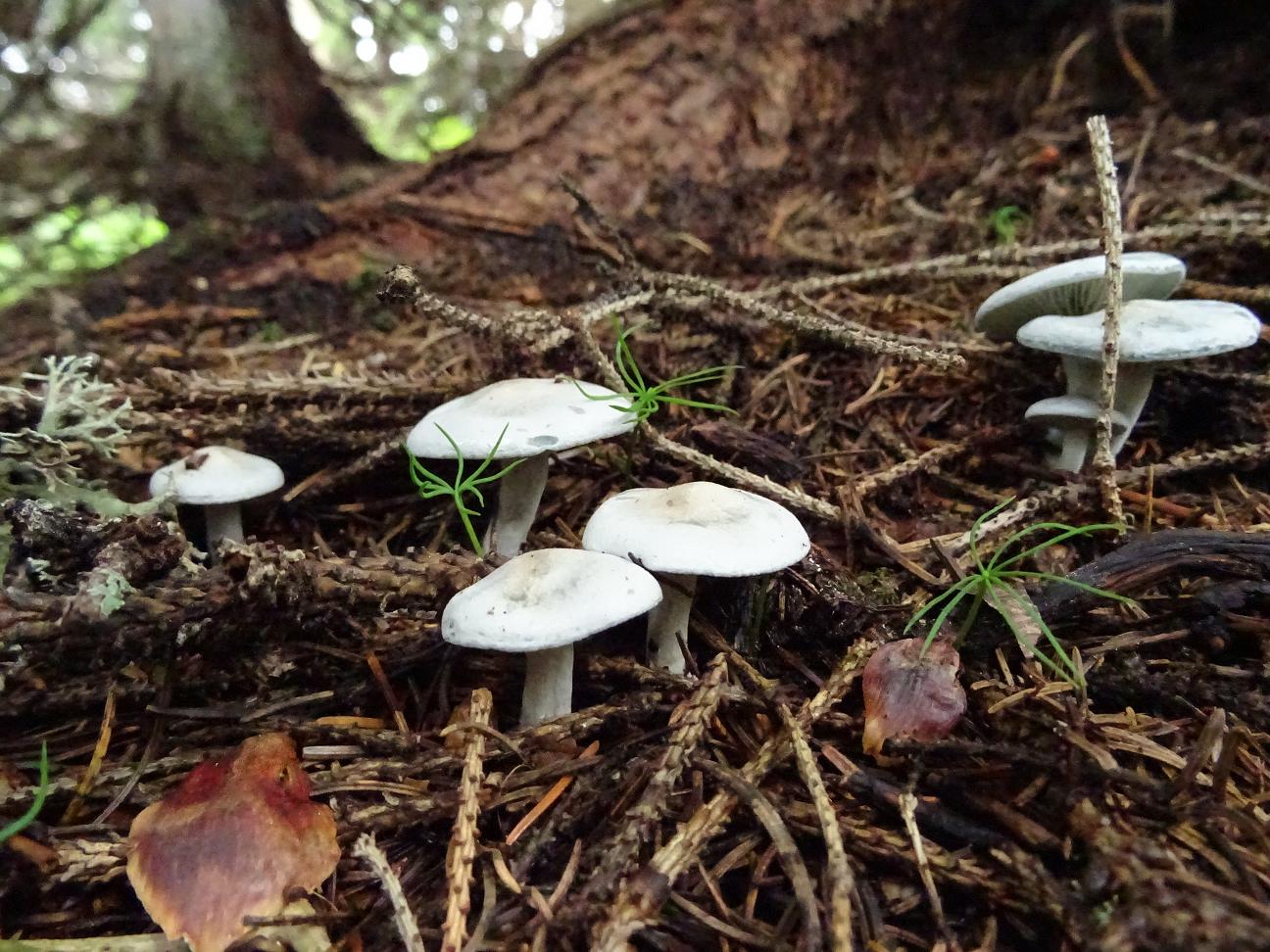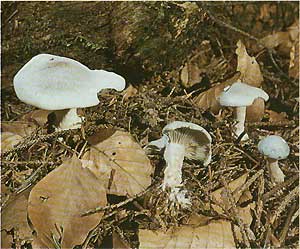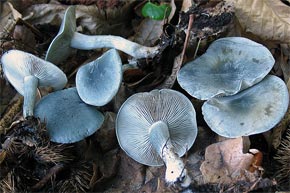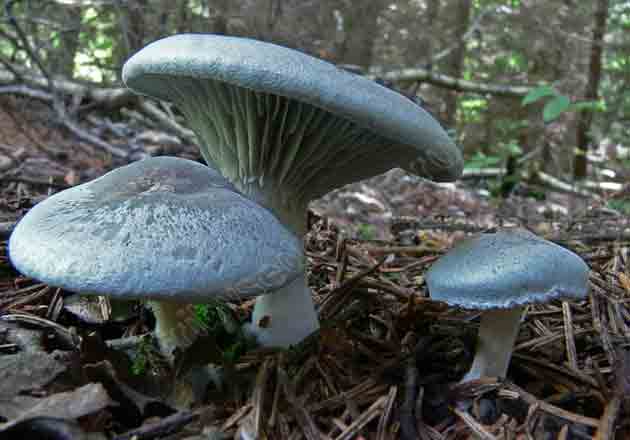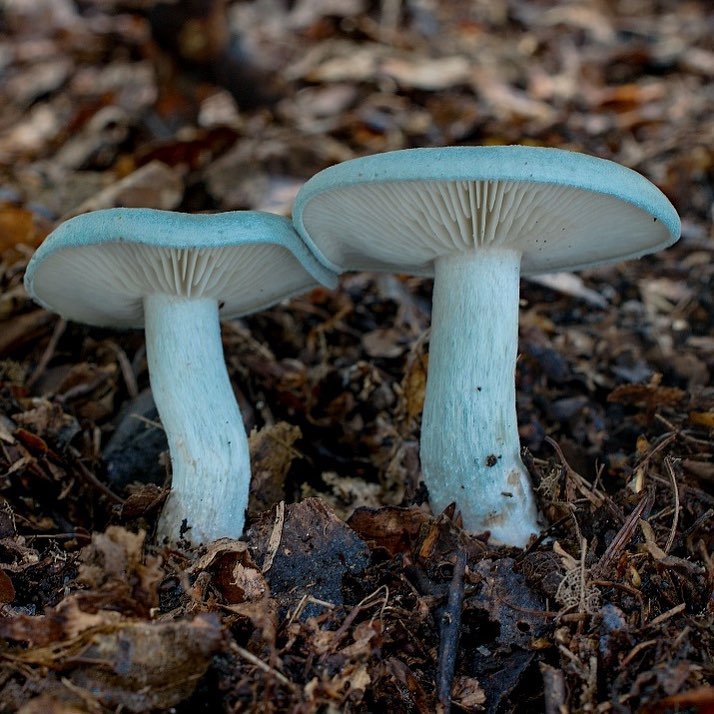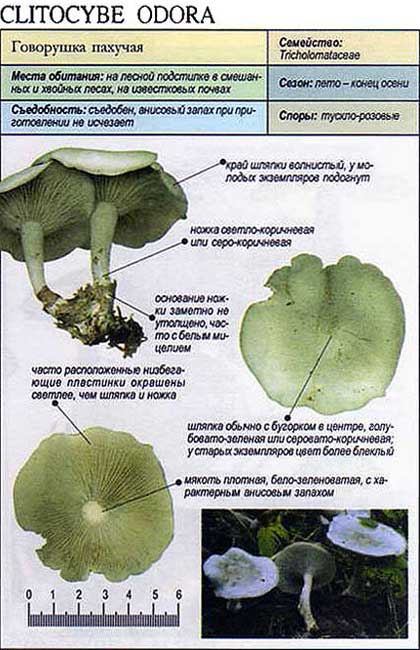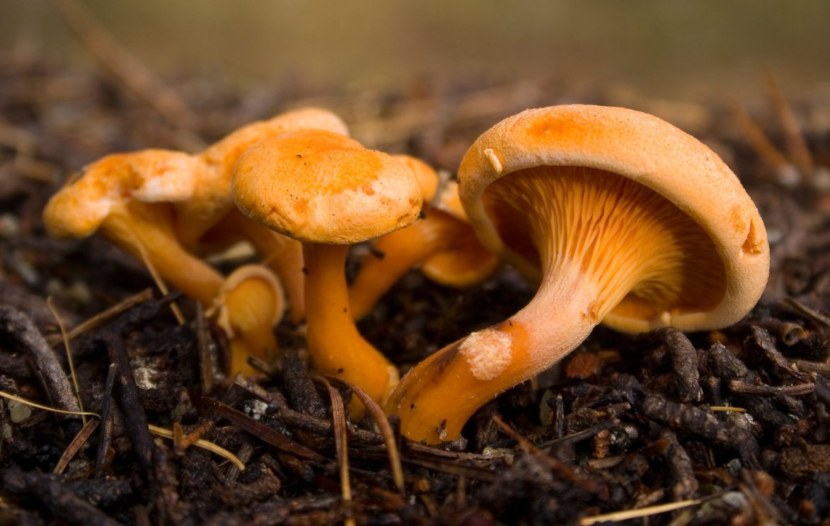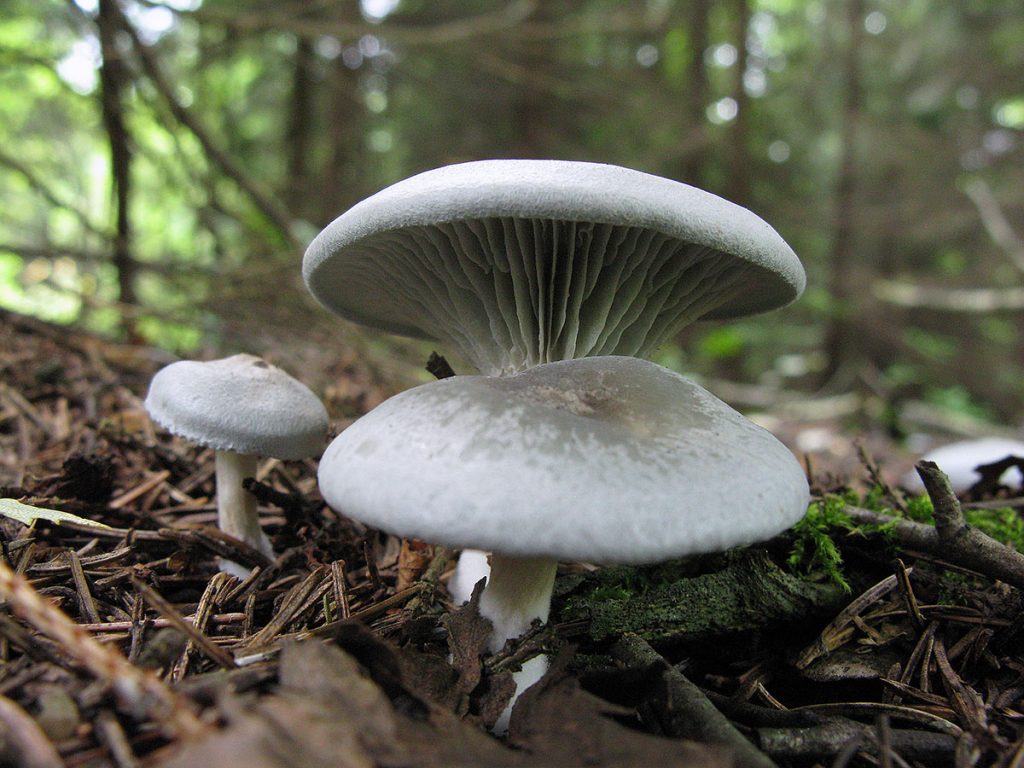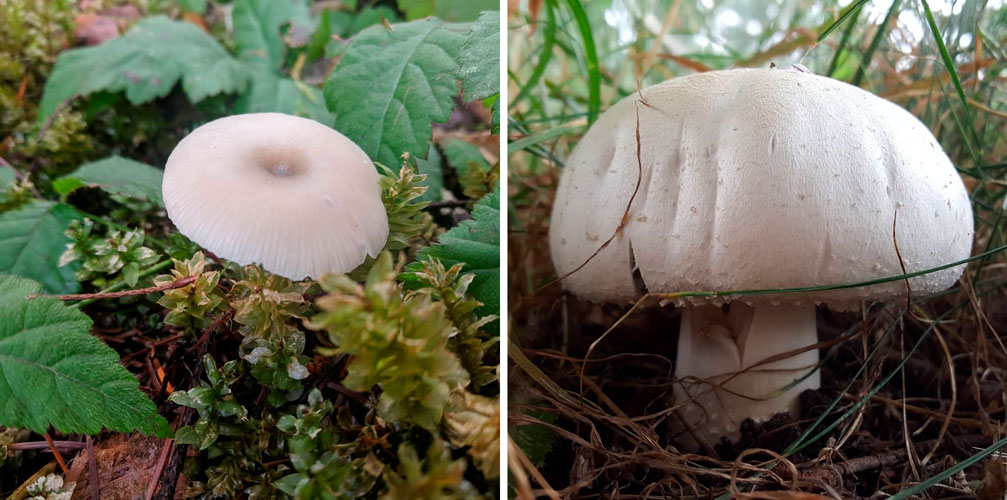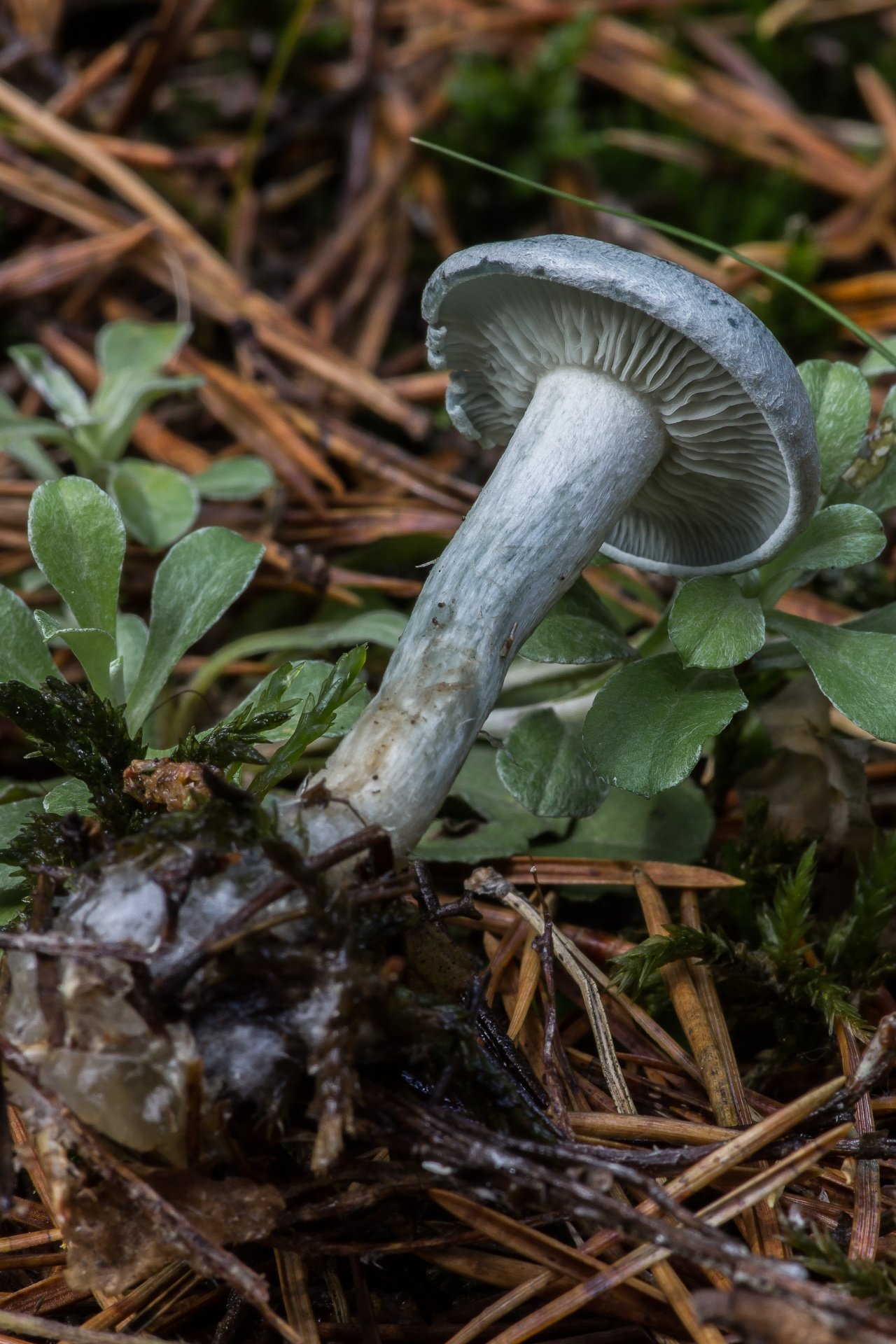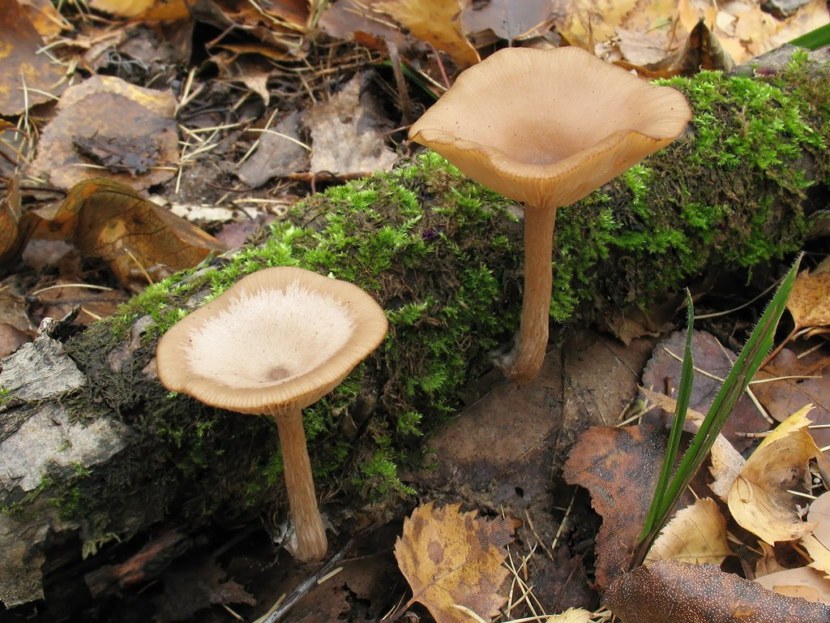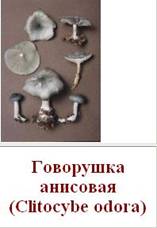What do odorous talkers look like
In order not to harm the body, you need to know the external description of the fungus, view photos and videos. The cap is small, about 10 cm in size. The surface of juveniles is convex, sky-olive in color. With age, it straightens, the edges fold, and the color changes to yellow-gray. When grown in an open area, the rind becomes discolored and cracked. The bottom layer is formed by frequent pale emerald plates. Reproduction occurs by cylindrical spores, which are located in a whitish spore powder. Leg, up to 8 cm long, dense, cylindrical, painted to match the cap.
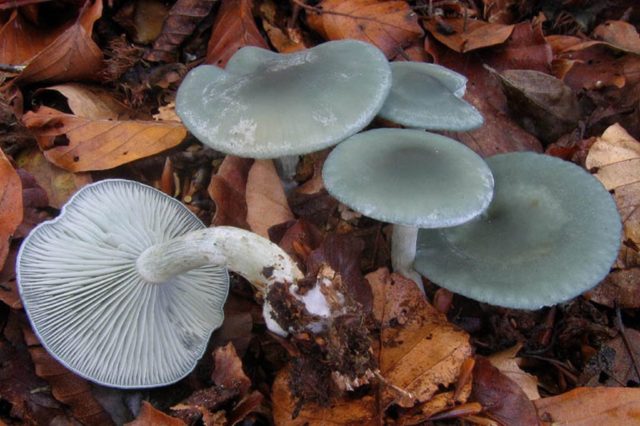
Claw-footed and funnel-footed talkers
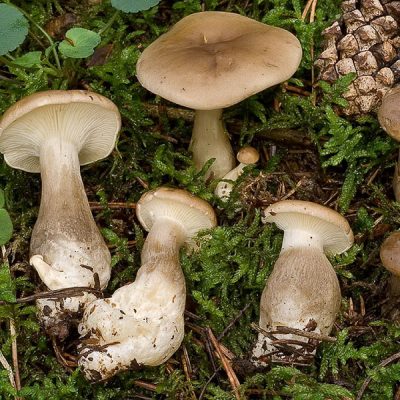 Clawfoot talker in the photo
Clawfoot talker in the photo 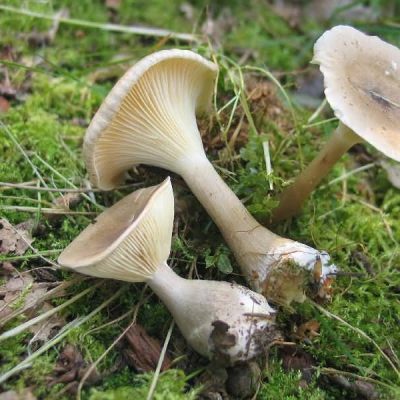 Fat-legged talker in the photo
Fat-legged talker in the photo
Mace-footed talker
(thick-legged talker, club-footed talker).
The cap is up to 8 cm in diameter, initially convex, then flat, in mature mushrooms it is funnel-shaped, with a raised thin edge, brown or gray-brown, fading. The plates are sparse, whitish, then yellowish, cream, descending to the stem. The pulp is moist, thin at the edges, whitish, with a faint flour smell. The leg is up to 8 cm high, clavate swollen, solid, fibrous, grayish-brownish, covered with mycelium bloom in the lower part. It prefers to grow in coniferous and mixed forests with an admixture of birch, singly and in small groups on the forest floor. Appears in August and grows until late autumn.
Cooking.
A little-known, edible conditionally edible, but not entirely tasty mushroom. In combination with alcohol, it acts as poisonous. After boiling and removing the broth, it can be boiled, fried, salted and pickled with other mushrooms.
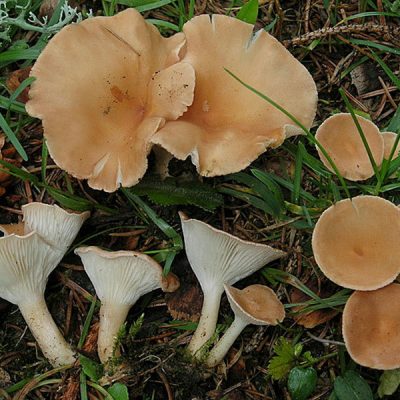 Funnel talker in the photo
Funnel talker in the photo 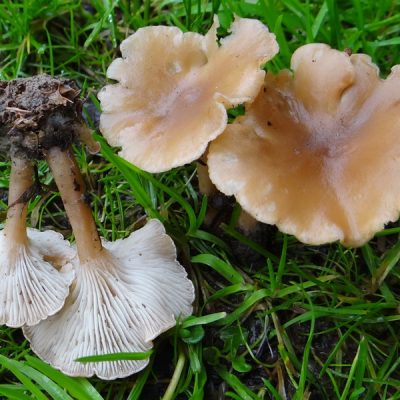 Funnel-shaped talker in the photo
Funnel-shaped talker in the photo
Funnel talker (funnel talker, funnels)
... The cap is up to 8 cm in diameter, with a protruding tubercle in the middle, during ripening it takes a deep-coronal shape, dry, with a winding edge, yellow-brown-fawn. The discs of the funnel-shaped talker are frequent, with small intermediate plates, descending down the leg. The pulp is thin, with a pleasant mealy odor. Leg up to 8 cm high, thin, rigidly elastic, solid, with white "felt" mycelium, which is involved in the decomposition of forest decay. This type is the most common among talkers. It grows in forests of various types on a forest floor of fallen leaves and needles in bushes, near paths, often, singly or in scattering, from summer to late autumn.
Cooking.
The mushroom is edible at a young age. It needs a long boil. Can be dried. Recommended to be consumed with other mushrooms.
Where talker mushrooms grow
Talkers are found in areas with a temperate climate.
Mushrooms are not whimsical to the growing area. They can be easily found in coniferous and mixed forests, on the edges, fields or meadows of France, European Russia, Poland, Spain and other European countries. They are also known to be found in parts of Asia and the Middle American continent. They prefer to grow in groups and form witch rings - these are kind of circles on the ground. In the old days, such patterns were tied to the intrigues of evil spirits. For a very long time, it was believed that witches or other evil spirits used these places at night for round dances and merrymaking.
Description of the species
The description and photo of the talkers allow you to have a clear idea of the external properties of this variety.
Upon visual inspection, the following characteristic features of this type of mushroom can be distinguished:
The hat of an adult is rather large. It varies from 5 to 25 cm. The shape is presented in the form of a hemisphere with edges curved inward.
As the fungus grows, it gradually straightens with a convex base near the center of the stem. During the rainy season, these mushrooms have a pronounced gray color.
On the surface of the cap there is a delicate skin on which a large number of leaves and spruce needles accumulate. With age, the amount of smoky plaque gradually decreases. The photo of talker mushrooms shows changes in the appearance of an adult mushroom.
The base of the stem has a cylindrical shape, which provides a tight fixation of the mushroom. The height is about 10-15 cm, and the diameter is around 5 cm.
The pulp of an adult mushroom has a fibrous structure. In the area of the cap, it is more fleshy. This breed is highly hygroscopic. When it rains, its weight significantly exceeds the allowable norm.
Under the head there are plates that have a beige-gray tint.
Spreading fragrant talker.
Fragrant talkers grow in deciduous forests and conifers. Fragrant talkers bear fruit from August to October. In warm, dry weather, aniseed talkers can be so numerous that a thick aroma spreads in the clearing. The smell from the talkers remains in the basket for a long time, even after the mushrooms have been taken out, cooked and eaten.
Evaluation of the edibility of odorous talkers.
You can eat the smelly talker, but the strong smell does not go away after cooking. Such mushrooms are not for everybody.

Properties and composition of aniseed talkers.
Aniseed talkers have an antibacterial effect. These mushrooms can be used to treat tuberculosis. They also contain clitocybin, which helps with epilepsy.

In addition, the caps of the odorous talkers contain vitamins B1 and B2, as well as manganese, copper and zinc.
Similar species.
Many talkers and ryadovki are similar to each other, it is very easy to confuse them. Unmistakably aniseed talker can be recognized by two signs: a characteristic aniseed smell and color. It is necessary to take into account both signs, and a single parameter does not say anything.

Relatives of aniseed talker.
The grooved talker is inedible. The cap is at first slightly convex, and later concave, in the middle there is an umbilical depression. Its color is gray-white or gray-brown. The surface is dry, watery consistency. The leg is curved, becomes hollow with age, there is a white fluff below. The pulp with a mealy taste and smell, soft.

Grooved talker is not a common mushroom. Most often it settles in pine forests, bears fruit from November to January. Grows in groups on spruce litter. Selects dry forests.

The winter talker is edible. At the beginning of growth, the shape of the cap is convex, later spread out, painting it thin, slightly sinuous. The color of the cap is smoky or brown-olive, when the mushroom dries up, the color becomes white-brown. The leg is cylindrical, hollow inside, matches the color of the cap, and brightens when it dries. The pulp is thin and elastic, with a flour smell and taste.
Winter talkers grow in conifers. Fruiting until late autumn. They settle on a coniferous litter.
Is the gray talker toxic
Once considered edible, this large and abundant mushroom is now classified as conditionally edible. It is not the most toxic mushroom, but it is seriously upsetting the gastrointestinal tract of some people who eat it, and therefore it is probably best avoided when picking mushrooms if there is a problem with the stomach and intestines.
Its aroma is also not in favor of this species. Some people find it "nauseous", when cooking, the smoky talker gives off a floral smell, to some it seems putrid and musty, sensitive people do not like it.
When the smoky talkers fully ripen or the fruiting bodies begin to disintegrate, parasitic parasitic parasitic fungi, volvariella, settle on them. It is always worth taking a closer look at each hat of the gray talker in case a white parasite has infected the host mushroom. Volvariella is inedible and poisonous.
Is it possible to poison with a false fox?
 Information about the toxicity and suitability for food of kokoschki has always been rather contradictory. Previously, it was unconditionally attributed to poisonous mushrooms and was considered inedible.Recently, this species is ranked as conditionally edible with a low nutritional value and is not recommended for use. In England, where the orange talker is eaten, there have been reports of cases of hallucinogenic effects after consuming it. In France, it is collected everywhere. In Russia, the false chanterelle is considered conditionally edible, requiring preliminary processing.
Information about the toxicity and suitability for food of kokoschki has always been rather contradictory. Previously, it was unconditionally attributed to poisonous mushrooms and was considered inedible.Recently, this species is ranked as conditionally edible with a low nutritional value and is not recommended for use. In England, where the orange talker is eaten, there have been reports of cases of hallucinogenic effects after consuming it. In France, it is collected everywhere. In Russia, the false chanterelle is considered conditionally edible, requiring preliminary processing.
But remember, all mushrooms tend to accumulate pollutants and heavy metals. Therefore, it is impossible to collect Gigroforopsis near industrial enterprises and highways, as this can lead to food poisoning.
Whitish Talker (Leucocybe candicans)
Synonyms:
- Agaricus candicans
- Agaricus gallinaceus
- Agaricus tuba
- Agaricus umbilicatus
- Clitocybe aberrans
- Clitocybe alboumbilicata
- Clitocybe candicans
- Clitocybe gallinacea
- Clitocybe gossypina
- Clitocybe phyllophila f. candicans
- Clitocybe tenuissima
- Clitocybe tuba
- Omphalia candicans
- Omphalia gallinacea
- Omphalia tuba
- Pholiota candicans

Description
The cap is 2 - 5 cm in diameter, in young mushrooms it is hemispherical with a tucked edge and a slightly depressed center; with age it gradually flattens to a broadly convex and flat with a depressed center or even funnel-shaped with a wavy edge. The surface is smooth, slightly fibrous, silky, shiny, white, becomes pale ocher with age, sometimes with a pinkish tinge, not hygrophane.
The plates are slightly descending, with a large number of plates, thin, narrow, rather frequent, but very thin and therefore do not cover the lower surface of the cap, straight or wavy, white. The edge of the plates is horizontal, slightly convex or concave, even or slightly wavy / serrated (a magnifying glass is required). Spore powder is white or pale cream at best, but never pinkish or flesh-colored.
Spores 4.5-6 (7.8) x 2.5-4 μm, from ovoid to ellipsoid, colorless, hyaline, usually solitary, do not form tetrads. Cortical hyphae 2 to 6 µm thick, with buckles.
A leg 3 - 5 cm high and 2 - 4 mm thick (approximately the diameter of the cap), rigid, of the same color as the cap, cylindrical or slightly flattened, with a smooth fibrous surface, slightly felt-like scaly in the upper part (a magnifying glass is required), in the base is often curved and overgrown with fluffy white mycelium, the strands of which, together with elements of the forest litter, form a ball from which the leg grows. The legs of adjacent fruiting bodies are often fused with each other at the bases.
The pulp is thin, when fresh, it is grayish or beige with white dots, when it dries it turns white. The smell is described in various sources as unexpressed (i.e., practically none, and only so), weak flour or rancid - but in no case flour. There is more unanimity with regard to taste - there is practically no taste.
Season and distribution
A widespread species of the Northern Hemisphere (from the north of Europe to North Africa), in places common, in places quite rare. The period of active fruiting is from August to November. It is found most often in mixed and deciduous forests, less often in open places with grassy cover - in gardens and pastures. Grows singly or in groups.
Similar species
Poisonous talker (Clitocybe phyllophila) is larger; strong spicy smell; a hat with a whitish bloom; adherent, only very weakly descending plates and pinkish-cream or ocher-cream spore powder. Poisonous whitish talker (Clitocybe dealbata) is rarely found in the forest, it is rather confined to open grassy places such as meadows and meadows. a flour smell (Many mushroom pickers describe it as the smell of spoiled flour - that is, quite unpleasant. Author's note), a matte cap, plates turning pink with age and a brownish-pink spore powder.
Photo: Alexander.
Poisoning by poisonous talkers
The pulp of poisonous talkers contains a fairly large amount of a strong toxin called muscarine.The symptoms of talker poisoning appear within a maximum of 3 hours:
- a disorder of the normal functioning of the gastrointestinal tract, expressed in severe nausea and vomiting, diarrhea and spasmodic contractions of the stomach and intestines;
- dysfunction of the cardiovascular system, manifested by a sharp decrease in blood pressure and the occurrence of sinus bradycardia;
- increased salivation and sweating;
- difficulty breathing normally, expressed in the form of bronchospasm or asthmatic manifestations;
- The most dangerous poisonous mushroom of the clithocybe genus is the leaf-loving gossip, she is waxy. Its pulp has a pleasant taste and smell. Often, symptoms of poisoning are practically not manifested. However, on the fifth day, a person who has tasted these mushrooms may die due to kidney failure.
Poisoning with talkers usually has no effect on the nervous system. The states of anxiety and causeless fear arise against the background of the general state of the organism. At the first signs of poisoning by talkers, you should immediately contact an ambulance.

Benefits and harm to the body
The fragrant talker is not only a low-calorie, but also a very useful mushroom. The fruit body contains proteins, fats, carbohydrates, fiber, a large amount of vitamins and amino acids. Due to its rich beneficial composition, the mushroom:
- improves digestion;
- removes toxins and toxins;
- stops the growth of cancer cells;
- reduces the level of bad cholesterol;
- prevents the formation of blood clots;
- strengthens the immune system.
Important! An ointment based on odorous talker heals and disinfects wounds. Since mushrooms are considered a heavy food, they are not recommended to be consumed:
- people with gastrointestinal diseases;
- pregnant and lactating women;
- children under 7 years old.
The species has false counterparts that cause food poisoning, so it is necessary to be able to find differences and follow the rules of collection.
Edible talkers with photos
In order not to confuse edible varieties with poisonous ones, they need to be able to distinguish them by their appearance. Distinctive features and description of edible varieties with photos are presented below.
Bent talker
This mushroom grows both singly and in large groups-circles, which are localized mainly at the edges of the forest, near roads and in thickets of bushes. The mushroom has a large smooth cap, the diameter of which often exceeds 12 cm. It is dirty yellow in color. The plates are white, gradually acquiring a pinkish tint.
The leg is dense in consistency and high, about 15-20 cm. The color is the same as the cap. The pulp is dry. In young mushrooms, it is white, and over time it becomes brown and acquires an unpleasant odor, therefore only young fruiting bodies need to be collected. The peak yield occurs at the end of summer and lasts until October. For cooking, only young mushrooms are used, which are pickled or boiled.
Gray
The hat of this variety is inferior in size to the previous one and has an average diameter of 8-15 cm. It is thick and fleshy in consistency, and can be in different shades of gray in color. The plates are also characterized by a gray tint. The leg is wide, dense, low, matching the color of the cap.
The pulp exudes a soap-like aroma. Most often, the mushroom is found in mixed and coniferous forests in large groups. It can be found in the forest from late summer to November. Before salting or pickling a gray talker, it must be thermally treated - boil for 30-40 minutes in boiling water.
Goblet
A special feature of this variety is a goblet-shaped hat with a diameter of about 7-8 cm. It has edges wrapped inward, a glossy surface and is painted brown or ash gray. There are few plates, they are brown in color. The pulp is thin, watery in consistency.
The leg is high, about 10 cm, part of the ground is fluffy and widened. You can meet the goblet variety in coniferous, mixed, deciduous forests, where the forest litter is rich in organic matter. The peak of fertility occurs in August and lasts until September inclusive. They eat the mushroom boiled or salted.
Orange
Orange talkers often grow in small groups or singly. Fruiting from late summer to October. They are found in the humid part of coniferous or mixed forests, the litter of which contains a large amount of moss and fallen rotten leaves.
The mushroom is small in size, yellow-orange in color, gradually becoming faded. The plates smoothly pass to the leg, when pressed, they change color to a darker one. The leg is low, on average 5 cm, rounded, becomes thinner closer to the ground. The pulp is yellowish, odorless. They eat only a hat that is fried or boiled.
Funnel
The name of the variety speaks for itself, since the shape of the cap is very much like a funnel, it is about 8 cm in diameter. The surface is dry, the edges are wavy, and has a dirty yellow color. The plates smoothly pass onto the leg. The pulp has a mealy odor. The leg is high, 8 cm long, thin, solid.
Funnel talkers belong to the most common varieties of this species, and they can be found on fallen leaves near forest paths, in thickets of bushes in small groups or singly. Heat treated before cooking. This species can be dried and also consumed together with other mushrooms.
Anisova
Anise talkers belong to the less common varieties of this type. The main feature of this variety is the changeable shape of the cap. So, initially the mushroom has a cap curved inward, which straightens over time. The color is predominantly green, with a gray tint. The leg is low, rounded.
Giant
You can meet a giant talker in open areas, where it grows from August to October. The hat has a funnel-shaped shape and edges bent outward. The diameter is 12-15 cm, but some representatives can grow up to 30 cm. The surface is pleasant to the touch, silky, milky in color. The leg is dense and high.
Read also Useful properties of hazelnuts for the human body
Where an inverted talker grows
The species is found in all types of forests, widespread in continental Europe and in many other parts of the world, including North America. Found on humus-rich soil, on wet sawdust and mulch on wood chips, but mainly in forest conditions, mycelium often produces impressive fabulous rings up to 20 meters in diameter.
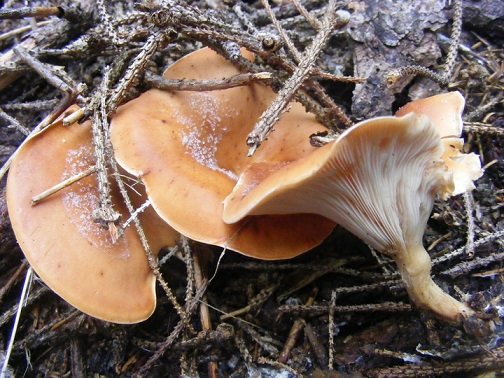
Etymology
Lepista in Latin means "wine jug" or "goblet," and the fully ripe caps of the Lepista species do become concave like shallow bowls or goblets. The specific definition of flaccida means "flabby", "sluggish" (as opposed to "strong", "tough") and describes the texture of this forest mushroom.
Edible and conditionally edible talker mushrooms
Edible mushrooms contain an optimal ratio of vegetable protein, vitamins, fiber and amino acids, which prevents the occurrence of various diseases. Also, these mushrooms are able to reduce plaque cholesterol in the blood.
Gray talker
Considered conditionally edible
... However, some scientists categorically classify it as poisonous. The hat has a smoky appearance and reaches a diameter of up to 15 cm. The color can change depending on weather conditions and even become orange-brown. Eating can cause poisoning due to the presence of a toxin called nebularin. White dense pulp changes color when cut. The harvest occurs at the end of August and lasts until the end of December. Basically, this species grows in long rows in the territories of the northern hemisphere in forests of any type.

Giant talker
It is a conditionally edible variety of the 4th category. As a rule, this species is collected exclusively for salting. Before cooking, even before drying, be sure to boil for 30-40 minutes. This species also has the names leusopaxillus huge, giant pig, white giant snow pig. Grows in mixed, deciduous and coniferous forests. It can often be found on the edges of the Caucasus. Giant talkers grow in large groups. The crop can be harvested until October.
It is possible to collect these mushrooms from August to October.
The hat has a yellowish or creamy shade, sometimes up to 30 cm in diameter. The flesh is tasteless and smells like flour. It contains an antibiotic and clitobicins, so this species is considered conditionally edible. The antibiotic is capable of destroying tuberculosis infection, and clitobicin kills germs.
These mushrooms are often used in traditional medicine to treat airway problems and lower blood cholesterol. It is also often used as an antiseptic.
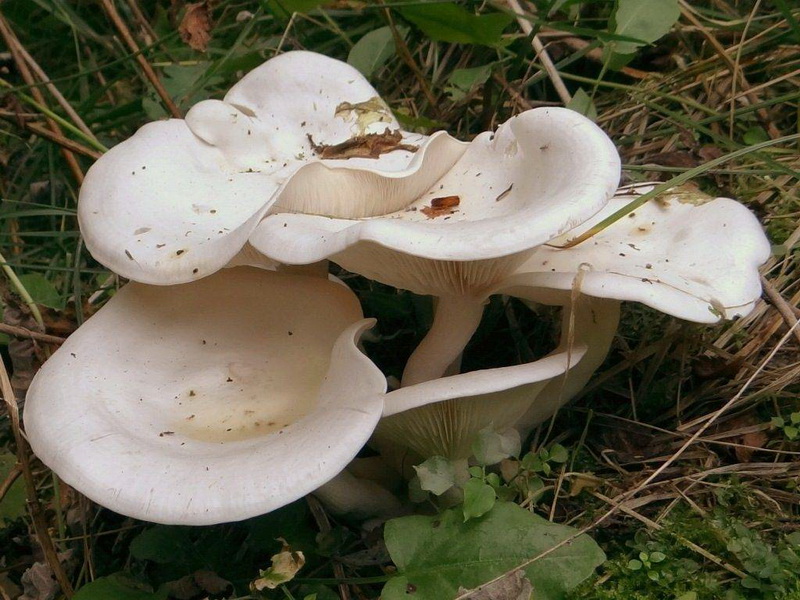
Anise talker
Also known as fragrant or fragrant. This variety grows mainly in spruce and mixed forests, where the Christmas tree predominates. Harvesting can begin in July. The hat reaches up to 6 cm and has a convex shape with a wavy rim. The surface color is light green with a blue tint. Another feature of the species is the length (up to 4 cm) and width (up to 1 cm) of the leg. To the base, the leg expands slightly and acquires a brownish tint. The flesh of the mushroom is distinguished by its strong aniseed odor and has a slightly greenish color.
The conceived aroma can be easily felt even without bending over to the ground.
The gift of the forest is eaten only after boiling. After that, you can fry it, add it to pies or salt it. It is better to choose young mushrooms with fleshy pulp.
This type of talker can be distinguished due to its specific smell and color. Field champignon has a very similar smell, but its color is very difficult to confuse.

Description
Goblet goblet is a dark brown funnel-shaped small mushroom.
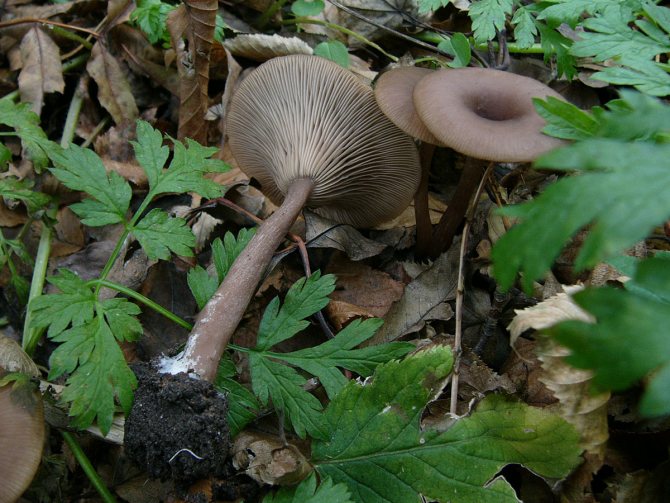
Size: up to 8 cm in diameter.
Shape: deep funnel or bowl, uneven edge, bent downwards.
Color: brown deep chocolate shade, may be darker in the center than at the edges.
Surface: dry, in wet weather, the cap is hygrophilous and turns gray.
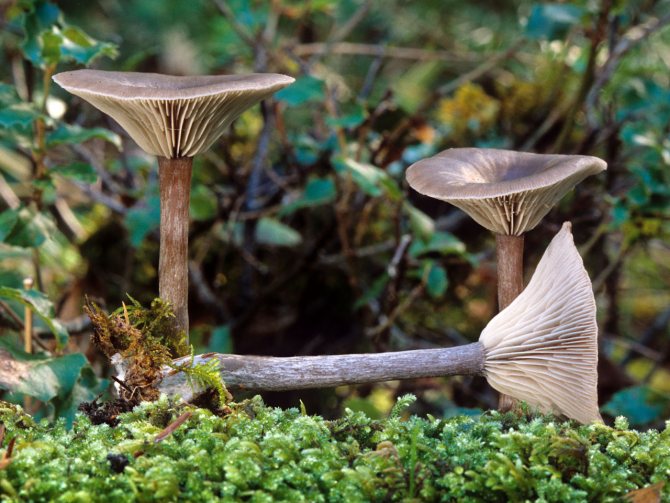
Size: from 4 to 7 cm * 0.5 cm in length and in diameter, respectively.
Shape: cylindrical, elongated, there is a cavity inside.
Color: grayish.
Surface: longitudinally striated.
Spore-bearing layer

Hymenophore type: lamellar.
Features: plates are rare, descending to the stem.
Color: gray or brownish.
Density: low, rather watery flesh.
Color: brownish.
Smell and taste: fruity aroma, pleasant, delicate taste.
Goblet goblet (Pseudoclitocybe cyathiformis)
Goblet goblet (Pseudoclitocybe cyathiformis) photo
The fungus is widespread. Grows in coniferous, mixed and deciduous forests on litter and rotten wood in August-September. The cap is 3-8 cm in diameter, goblet or cupped, grayish-brown, with a curled edge. The pulp is thin, watery, of the same color as the cap, the taste and smell are pleasant.
The plates are sparse, light brown or grayish brown, lighter than the caps, running down to the stem. Leg 3-10 cm long, 0.5-0.6 cm thick, the same color with the cap, hollow. Goblet goblet is edible, used boiled, salted and pickled.

